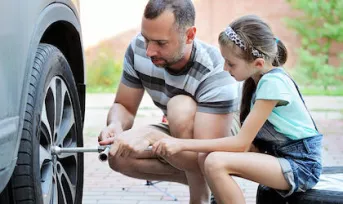
How to Build a Stylish Wardrobe on a Budget
Who else is ready for sweater weather? 🙋♀️ This transitional period between summer and fall is the perfect time to reassess what’s in your closet, get rid of clothes you no longer wear, and snag end-of-season deals.
In this comprehensive guide, we'll explore setting a clothing budget, how to find used clothes, when to shop clearance sales, and more!
Set a budget and plan your purchases
Building a wardrobe on a budget starts with setting a clear spending limit and planning your purchases strategically. This approach ensures you spend wisely and make the most of every dollar.
Assess your current wardrobe
Take a thorough inventory of your existing clothes. This crucial step helps you identify what you need and avoid unnecessary buys. Here’s how to assess your current wardrobe:
- Sort and organize. Go through your closet and any seasonal clothing items you’ve stored away. Sort each garment into categories like tops, dresses, bottoms, and outerwear. This organization will provide a clear overview of what you already have.
- Check for wear and tear. Set aside clothes that need repairs and consider donating or selling items you no longer wear to make room for new pieces.
- Identify any gaps. Make a list of clothing items and accessories you need to complete your wardrobe.
Create a shopping list
Arming yourself with a shopping list can help you stay focused and on budget. Prioritize essential items that you need immediately, such as a lightweight jacket for fall, and set price limits on each item based on your overall budget.
➢RELATED: How to Create a Budget
Allocate funds wisely
If you need to purchase several items at once, like for your growing kid’s back-to-school wardrobe, budget for different clothing categories separately. Here are some tips to help you distribute your budget:
- Invest in quality basics. Allocate a larger portion of your budget to durable, timeless basics that form the foundation of your wardrobe.
- Spend less on trends. Reserve a smaller portion of your budget for trendy items that may go out of style quickly.
- Buy secondhand clothes. Shop for gently used pieces at thrift stores, consignment shops, and online marketplaces.
Thrift for treasures
Buying secondhand clothes is a fantastic, sustainable way to build an affordable wardrobe. With some patience and a keen eye, you can score unexpected gems that will elevate your look at a fraction of the cost.
Benefits of thrifting
Thrifting offers numerous benefits that go beyond saving money. Here are some key advantages:
- Cost-effective. Thrift stores often have significantly lower prices than regular retail stores, allowing you to stretch your budget further.
- High-quality items. Many thrift stores carry high-quality, durable items that can last for years if properly cared for.
- Unique finds. You can discover unique, vintage, or designer pieces that are no longer available in retail stores.
- Sustainable shopping. Buying secondhand reduces waste and promotes recycling, making it an eco-friendly choice.
➢RELATED: Living Green on a Budget
5 essential thrifting tips
To make the most of your thrifting trips, keep these tips in mind:
- Visit regularly. The inventory at thrift stores changes frequently — sometimes even daily. Regular trips increase your chances of finding great items, so aim to stop by at least once a week if you’re on the hunt for specific items.
- Go early. Arriving just after the store opens can give you first pick of new arrivals and the best selection. Ask the employees when they typically put out new clothing and plan your visits around inventory changes.
- Check every section: Don’t limit yourself to the clothing section marked with your size. One of the best things about thrift stores is that great finds are often hidden in unexpected places.
- Inspect items carefully: Check for any damage, stains, or wear. Minor issues like missing buttons can often be easily fixed, but major flaws might not be worth the hassle.
- Try things on: Sizes can vary significantly between brands and eras, so always try on items to ensure a good fit.
Shop end-of-season clearance sales
The end-of-season clearance is a prime opportunity to update your wardrobe with new clothes at marked-down prices. Retailers need to make room for incoming stock, which means you can snag high-quality items for a bargain!
Timing your purchases
Knowing when to shop is key to scoring the best deals. Actual sale dates for individual retailers will vary, but it’s generally a good rule of thumb that stores start marking down clothing two to three months after the start of a season.
| Season | When to shop | What to buy |
| Summer | Mid-August through Labor Day weekend | Discounted summer clothing, including swimwear, shorts, and sandals. |
| Fall | Late October to early December | Cozy essentials like jackets, scarves, and jeans. |
| Winter | Late January through March | Winter coats, sweaters, boots, and cold-weather accessories. |
| Spring | Mid-April to early June | Transitional pieces, dresses, light jackets, and raincoats. |
What to look for during clothing sales
To maximize your savings and ensure you’re getting items that will serve you well, keep these tips in mind:
- Focus on staples. Prioritize essential items that you’ll wear frequently, such as plain tees, jeans, work garments, and outerwear.
- Check for quality. Even at discounted prices, it's important to invest in well-made pieces that will last. Look for sturdy fabrics and good construction.
- Consider next year. Since these are end-of-season clearance sales, think ahead and purchase garments you know you’ll wear next year, not just the last few weeks of this season.
- Versatility is key. Choose pieces that can be mixed and matched with your existing wardrobe to maximize their usability.
Online vs. in-store clearance sales
Both online and in-store shopping have their advantages during clearance sales.
Online shopping
- Convenience. Shop from the comfort of your home and easily compare prices across different retailers.
- Exclusive deals. Some retailers offer online-only discounts or early access to clearance sales.
- Wide selection. Access a broader range of sizes and styles than you might find in-store.
In-store shopping
- Immediate access. See and try on items before buying, ensuring a better fit and avoiding return hassles.
- Additional discounts. Stores may offer extra markdowns on clearance items that aren’t advertised online.
- Local finds. Discover unique pieces that may not be available online.
Combining both approaches can yield the best results. Start by browsing online to identify great deals and then visit local stores to see if you can find similar or better offers.
Upcycle your clothes
Upcycling is a creative and sustainable way to refresh your wardrobe without spending much money. By transforming old or unused clothing into new, stylish pieces, you can breathe new life into your wardrobe and express your personal style.
Simple upcycling projects
Starting with simple projects can ease you into the world of upcycling. Here are a few easy and fun ideas to get you started:
- Off-shoulder tee. Transform an old t-shirt into a stylish off-shoulder top by cutting a wide neckline and sewing down the new hem.
- Cut-off shorts. Turn worn-out jeans into fashionable shorts by cutting them to your desired length and fraying the hem.
- Sweater mittens. Repurpose an old sweater into cozy mittens. Cut out mitten shapes from the sweater fabric, sew the edges together, and you have a warm accessory for winter.
Benefits of DIY fashion
Upcycling and DIY fashion offer numerous benefits beyond just updating your wardrobe.
- Cost-effective. Upcycling allows you to create new clothing items without buying new materials, saving you money.
- Sustainable. By repurposing old clothes, you reduce waste and minimize your environmental footprint.
- Unique. DIY fashion enables you to create one-of-a-kind pieces that reflect your personal style, ensuring your affordable wardrobe is unique.
- Creative outlet. Upcycling provides a creative outlet and a sense of accomplishment as you transform old items into something new and fashionable.
- Skill development. Engaging in DIY projects helps you develop valuable skills like sewing, embroidery, and design.
Create a capsule wardrobe
Creating a minimalist capsule wardrobe is a powerful strategy for building a stylish, functional, and budget-friendly collection of clothes. This approach focuses on selecting versatile pieces that can be mixed and matched to create a variety of outfits, reducing the need for excessive shopping.
What is a capsule wardrobe?
A capsule wardrobe is a curated collection of clothing that includes only essential and versatile pieces. By choosing a neutral base color palette like black, navy, or gray and a few accent colors, you ensure each garment will pair well with multiple other items in your wardrobe.
The goal is to maximize the number of outfits you can create with a limited number of pieces.
Benefits of a capsule wardrobe
- Long-term savings. By focusing on quality over quantity, you reduce the need for seasonal shopping trips and spend less on clothing overall.
- Simplifies decision-making. With a select number of versatile pieces, figuring out what to wear becomes quicker and easier.
- Reduces clutter. A capsule wardrobe minimizes the amount of clothing you own, making your closet more organized and manageable.
Be patient and shop with intent
Building a stylish, affordable wardrobe on a tight budget requires patience and a strategic approach to shopping.
Avoid impulse buys
Impulse buying is a common pitfall that can quickly derail your budget. To prevent impulsive purchases, make a list of specific items you need and stick to your clothing budget. If you see something you like but had no plans to buy, wait at least 24 hours before purchasing. This cooling-off period can help you determine if the item is truly a necessary addition to your wardrobe.
Research before you buy
Look up items on multiple retailer websites to compare prices, upcoming sales, and discounts. You’ll also want to read reviews to gauge the quality and fit of an item. Ensure the store you shop at has a good return policy in case the garment doesn’t work out.
Wait for the best deals
In addition to end-of-season sales, many retailers hold major sales events throughout the year. These typically correspond with federal holidays, back-to-school shopping, and tax-free weekends.
➢RELATED: 9 Ways to Get Help with Back-to-School Supplies
Bringing it all together: Your path to a budget-friendly wardrobe
With the right approach, creating a stylish wardrobe on a budget is more achievable than you might think. By setting a clothing budget, prioritizing your needs, exploring thrifting and upcycling, and shopping end-of-season clearance sales, you can build a functional and fashionable wardrobe without overspending.
Want more budget-friendly shopping tips? Follow Advance America on Facebook and Instagram!
Notice: Information provided in this article is for informational purposes only. Consult your attorney or financial advisor about your financial circumstances.


